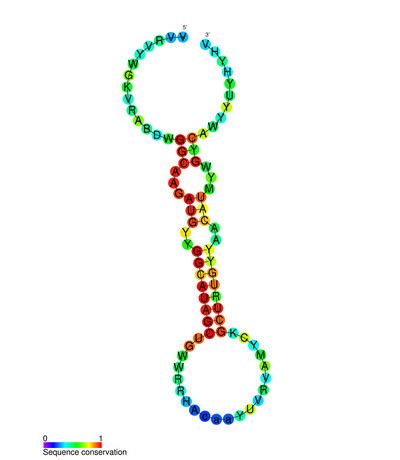Symbol mir-31 miRBase family MIPF0000064 Domain(s) Eukaryota; | Rfam RF00661 SO {{{SO}}} | |
 | ||
miR-31 has been characterised as a tumour suppressor miRNA, with its levels varying in breast cancer cells according to the metastatic state of the tumour. From its typical abundance in healthy tissue is a moderate decrease in non-metastatic breast cancer cell lines, and levels are almost completely absent in mouse and human metastatic breast cancer cell lines. There has also been observed a strong encapsulation of tumour cells expressing miR-31, as well as a reduced cell survival rate. miR-31's antimetastatic effects therefore make it a potential therapeutic target for breast cancer. However, these two papers were formally retracted by the authors in 2015.
Contents
Functions
mir-31 has been linked to Duchenne muscular dystrophy − a genetic disorder characterised by a lack of the protein dystrophin − as a potential therapeutic target. Duchenne muscular dystrophy is caused by mutations arising in the dystrophin gene, which impair the translation of dystrophin through the formation of premature termination codons.
miR-31 overexpression is more abundant in human Duchenne muscular dystrophy than in healthy controls, with levels remaining high only in Duchenne muscular dystrophy myoblasts. miR-31 levels in healthy controls are instead decreased with the onset of cell differentiation. miR-31 is part of the circuit controlling late muscle differentiation by repression of dystrophin synthesis, and its expression is localised specifically to regenerating myoblasts of dystrophic muscles. miR-31 is believed to repress the expression of dystrophin by antisense binding of the dystrophin mRNA 3' untranslated region, and in this way it is thought that miR-31 manipulation could aid treatment for Duchenne muscular dystrophy.
Applications
In serous ovarian cancer, miR-31 is frequently deleted and is the most underexpressed microRNA in this cancer type. It has been shown to affect the levels of gene transcription factor p53, responsible for encoding the tumour suppressor protein p53. Cancer cell lines with an inactive p53 pathway show a vulnerability to miR-31 overexpression, whilst there is resistance to overexpression in cell lines with a functional p53 pathway. miR-31 overexpression is associated with a better prognosis in tumours, suggesting that therapeutic delivery of miR-31 may be beneficial in patients with p53-deficient cancers. Conversely, in gastric cancer miR-31 levels have been found to be significantly lower in tumour cells relative to healthy cells, meaning further potential for use as a diagnostic marker. Interestingly, however, high expression levels of miR-31 correlate to shorter survival in patients with malignant pleural mesothelioma, whereas longer survival has been associated with normal/low expression of miR-31 from blood-based samples.
miR-31 has further been shown to negatively regulate FOXP3, the master regulator in T-lymphocyte development and function. This is through direct binding of miR-31 at its target site in the 3'UTR of FOXP3 mRNA.
